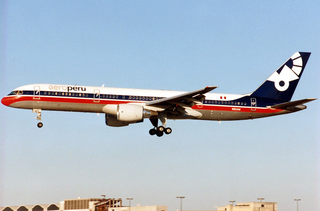
The Linate Airport disaster occurred in Italy at Linate Airport in Milan on the morning of Monday, 8 October 2001. Scandinavian Airlines System Flight 686, a McDonnell Douglas MD-87 airliner carrying 110 people bound for Copenhagen, Denmark, collided on take-off with a Cessna Citation CJ2 business jet carrying four people bound for Paris, France. All 114 people on both aircraft were killed, as well as four people on the ground.

Swissair Flight 111 was a scheduled international passenger flight from John F. Kennedy International Airport in New York City, United States, to Cointrin Airport in Geneva, Switzerland. This flight was also a codeshare flight with Delta Air Lines. On 2 September 1998, the McDonnell Douglas MD-11 performing this flight, registration HB-IWF, crashed into the Atlantic Ocean southwest of Halifax Stanfield International Airport at the entrance to St. Margarets Bay, Nova Scotia. The crash site was 8 kilometres from shore, roughly equidistant from the small fishing and tourist communities of Peggy's Cove and Bayswater. All 229 passengers and crew on board the MD-11 were killed, making the crash the deadliest accident in the history of Swissair and the deadliest accident involving McDonnell Douglas MD-11.

Aeroperú Flight 603 was a scheduled passenger flight from Miami International Airport in Miami, Florida, to Comodoro Arturo Merino Benítez International Airport in Santiago, Chile, with stopovers in Quito, Ecuador, and Lima, Peru. On October 2, 1996, the Boeing 757-23A aircraft flying the final leg of the flight crashed, killing all 70 people aboard.

Japan Air Lines Flight 123 was a scheduled domestic passenger flight from Tokyo to Osaka, Japan. On August 12, 1985, the Boeing 747 operating the service suffered a severe structural failure and decompression 12 minutes into the flight. After flying under minimal control for a further 32 minutes, the 747 crashed in the area of Mount Takamagahara, 100 kilometres from Tokyo.

On the night of Monday, 1 July 2002, BALBashkirian Airlines Flight 2937, a Tupolev Tu-154 passenger jet, and DHL International Aviation ME Flight 611, a Boeing 757 cargo jet, collided in midair over Überlingen, a southern German town on Lake Constance, near the Swiss border. All of the passengers and crew aboard both planes were killed, resulting in a total death toll of 71.

United Airlines Flight 585 was a scheduled passenger flight on March 3, 1991, from Denver to Colorado Springs, Colorado, carrying 20 passengers and 5 crew members on board. The plane experienced a rudder hardover while on final approach to runway 35 at Colorado Springs Municipal Airport, causing the plane to roll over and enter an uncontrolled dive. All 25 people on board were killed.
Seconds from Disaster is a US/UK-produced documentary television programme that investigates historically relevant man-made and natural disasters from the 20th and early 21st centuries. Each episode aims to explain a single incident by analyzing the causes and circumstances that ultimately effected the disaster. The program uses re-enactments, interviews, testimonies, and CGI to analyze the sequence of events second-by-second for the audience.

Vitaly Konstantinovich Kaloyev is a Russian former architect and convicted murderer who was found guilty of the premeditated killing of an air traffic controller after his family died aboard BAL Bashkirian Airlines Flight 2937, which collided with DHL International Aviation ME Flight 611 over Überlingen, Germany, on 1 July 2002.

Aeroflot Flight 593 was a passenger flight from Sheremetyevo International Airport, Moscow, Russia, to Kai Tak Airport in Hong Kong. On 23 March 1994, the aircraft operating the route, an Airbus A310-304 flown by Aeroflot, crashed into the Kuznetsk Alatau mountain range in Kemerovo Oblast, killing all 63 passengers and 12 crew members on board.

South African Airways Flight 201 (SA201), a de Havilland Comet 1, took off at 18:32 UTC on 8 April 1954 from Ciampino Airport in Rome, Italy, en route to Cairo, Egypt, on the second stage of its flight from London, England to Johannesburg, South Africa. The flight crashed at around 19:07 UTC, killing all on board. The flight was operated as a charter by British Overseas Airways Corporation (BOAC) using the aircraft G-ALYY, with a South African crew of seven, and carrying fourteen passengers.
Mayday, entitled Air Crash Investigation in Canada, Australia, New Zealand, South Africa, the United Kingdom, India, other Asian countries, and some European countries, and Air Emergency, Air Disasters, and Mayday: Air Disaster in the United States, is a Canadian documentary television program examining air crashes, near-crashes, hijackings, bombings, and other disasters. Mayday uses re-enactments and computer-generated imagery to reconstruct the sequence of events leading up to each disaster. In addition, survivors, aviation experts, retired pilots, and crash investigators are interviewed, to explain how the emergencies came about, how they were investigated, and how they might have been prevented.

Atlantic Southeast Airlines Flight 529 was an Embraer EMB 120 Brasilia aircraft that crashed in the community of Burwell between the cities Bowdon, Georgia and Carrollton, Georgia, on August 21, 1995. Nine of the 29 passengers and crew on board were killed as a result of the accident. The accident bore similarities to Atlantic Southeast Airlines Flight 2311, which had occurred four years earlier, and resulted in the deaths of all 23 people on board. The inquiries of both crashes concluded that design flaws in the aircraft's propellers were to blame.

Bristow Helicopters Flight 56C was a helicopter flight that flew between Aberdeen and the Brae Alpha oil rig in the North Sea. On 19 January 1995, the AS 332L Super Puma helicopter operating the route, registered G-TIGK and named Cullen, was struck by lightning. The flight was carrying 16 oil workers from Aberdeen to an oil platform at the Brae oilfield. All 18 people on board survived.
Blueprint for Disaster is a Canadian documentary television series that premiered in 2004 on Discovery Channel Canada. Produced by Temple Street Productions, the program investigates why and how various disasters have happened. Toronto-based Voice Artist Adrian Bell provided the narration for the first series. The show also aired in the UK under the title Seconds from Disaster. As of 2008, two seasons have been produced.
Seismic Seconds is a documentary television series that aired in the late 1990s on the National Geographic Channel. The program analysed the causes of six incidents, five involving the loss of human life. The better-known sequel to Seismic Seconds, Seconds From Disaster, was spun off from the series.
Critical Situation is an American documentary television series. Produced in conjunction with the National Geographic Channel, the series examined various disasters or violent incidents. It replaced Seconds From Disaster, a similar program with a more forensic approach. The main tagline of the show reads, "This is Situation Critical," or some variation thereof. As of November 2007, 13 episodes have been aired.

On January 31, 2001, Japan Airlines Flight 907, a Boeing 747-400 en route from Haneda Airport, Japan, to Naha Airport, Okinawa, narrowly avoided a mid-air collision with Japan Airlines Flight 958, a McDonnell Douglas DC-10-40 en route from Gimhae International Airport, South Korea, to Narita International Airport, Japan. The event became known in Japan as the Japan Airlines near miss incident above Suruga Bay. Had the accident occurred, it could have potentially been either the worst mid-air collision, to the worst air disaster of all time.

Korean Air Flight 801 was a scheduled international passenger flight operated by Korean Air. The flight crashed on August 6, 1997, on approach to Antonio B. Won Pat International Airport, in the United States territory of Guam, killing 229 of the 254 people aboard. The aircraft crashed on Bijia Peak, south of Nimitz Hill, in Asan-Maina, Guam, while on approach to the airport. The National Transportation Safety Board cites poor communication between the flight crew as probable cause for the air crash, along with the captain's poor decision-making on the non-precision approach. It remains the deadliest aviation disaster in the United States and its territories to have survivors.

USAir Flight 427 was a scheduled flight from Chicago's O'Hare International Airport to Palm Beach International Airport, Florida, with a stopover at Pittsburgh International Airport. On Thursday, September 8, 1994, the Boeing 737 flying this route crashed in Hopewell Township, Pennsylvania while approaching Runway 28R at Pittsburgh, which was at the time USAir's largest hub.













